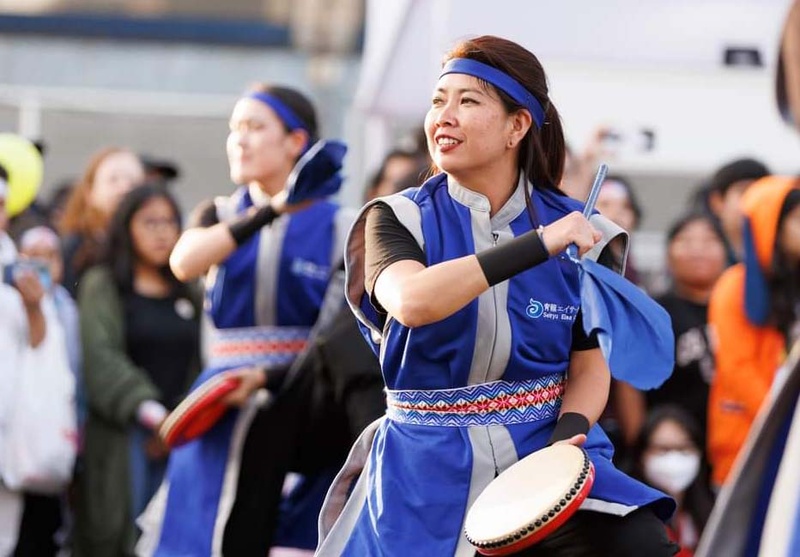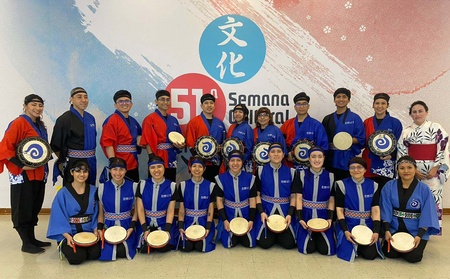Aiko Yamada Yoshimoto grew up in Lima, Peru, but her connection to traditional eisa dance of Okinawa became more important at a time when she lived far away from her country. She grew up in an artistic family. Her maternal grandparents are from Nago and in her house there were instruments such as the koto and sanshin that nobody played. “My great-grandmother played the koto, but no one else did. I was interested in music, so I started playing by ear.”
First she learned to play keyboards and then moved on to guitar, but deep down what most resonated with Aiko was the traditional music that accompanied eisa dancing that she heard at home. “My oyichan (grandfather) always talked about his homeland and I imagined the beaches. My obachan (grandmother) talked to me about my great-grandmother, who was a very accomplished dancer, and she also showed me some basic steps.”
At La Unión school, she joined the first call for eisa dancers and practiced for two months, until she had to travel abroad and missed the undokai of 1999. “I wanted to start dancing again and a friend told me that there was a group that danced eisa.” She joined them, but couldn’t continue because of her schedule. After a while, she decided to cultivate her passion once again. That’s when the trip to Japan happened.
Art in Movement
“At first I majored in advertising, but it was difficult to afford it, so I went to work in Japan.” Once there, Aiko worked in a factory where she was required to wear a uniform that covered her eyes, making it difficult to see. To combat the isolation and sadness, she listened to eisa music, which reminded her of life in Peru, with her friends and grandparents.
After returning to Peru, Aiko contacted her friends from the dance group and met Cecilia Nué, founder of Seiryu Eisa Kai. She joined the group and since then has been dancing and performing in shows. “I started to dance, remembering the steps and attending weekly practices. Ceci created a very tight group that has been together since 2017,” Aiko says.
For Aiko, eisa dancing is designed so that when each movement is executed correctly, it’s impossible to hurt yourself. “The way you lift your body and move your arms is made for that,” she adds. She also says that one of the challenges of eisa is dancing while playing an instrument, which was difficult in the beginning. “You have to be really synchronized.”
Unity and Memories
Aiko Yamada recalls listening to many of the eisa songs with her friends, which is why she connected strongly with those songs “during a very difficult period, when I had to leave the country.” The music brought back many memories, such as when her oyichan died when she was 9 or 10 years old, during the years of terrorism in Peru. “We lived in Miraflores and there were blackouts. My “oyi” sang songs from Okinawa to calm me down when we heard bombs exploding,” she remembers.
While eisa rituals are associated with the end of obon, a Buddhist festival to honor the dead, for Aiko they have a different meaning. “I imagine myself on the beaches of Okinawa where the sand is shaped like stars. I think of the colorful shirts they wear, and the joyful atmosphere that distinguishes people from that place.”

Over time, the original significance of eisa is gradually being lost, but it takes on new meaning through music and dance. “Seiryu Eisa Kai is known for combining eisa with pop music, so the dances are more dynamic.” Aiko remembers one show in which she forgot to wear her tekkos (wristbands) and only realized it once she was on stage. When she told the other dancers, they removed their wristbands so they would all look the same.
“That unity is what motivates me. When I’m there I feel good. We’re a family,” says Aiko, who is happy to see new people join the group, since there is always space to continue innovating with music and dancing. “There’s a lot of interest in it, even among people who aren’t Nikkei, but who know a lot about it. Japanese culture is very rich, and Okinawan culture is quite unique. It’s entertaining, warm, hospitable, and friendly…that’s the beauty of it, in addition to the scenery and the music.”
*Seiryu Eisa Kai: YouTube | Facebook | Instagram (@seiryueisakai)
* * * * *
Saturday, March 9, 2024 • 3 p.m. PST (ZOOM)
Join us for a conversation and Q&A with members of contemporary eisa groups—Lisa Tamashiro Maumalanga (Chinagu Eisa Hawaii), Rentaro Suzuki (Ryukyukoku Matsuri Daiko Los Angeles Branch), John Azama (Ryukyu Damashii), Cecilia Nué (Seiryu Eisa Kai), and Toshiyuki Yamauchi (Yuriki no Kizuna Eisá Daiko)—as they discuss how eisa connects them to their cultural heritage and identity. An interactive beginners tutorial and opportunity to talk with members from various eisa groups will follow the program.
The main program will be presented via Zoom, with simultaneous translation in English, Spanish, and Portuguese. Registration is required.
© 2024 Javier García Wong-Kit








